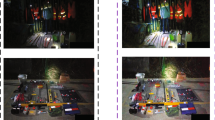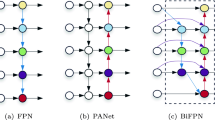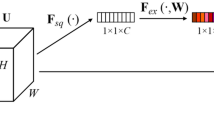Abstract
To deal with the poor generalization of previous deep learning-based methods, a novel anchor-free deep learning framework called CA-CentripetalNet is proposed for hardhat wearing detection. Two novel schemes are proposed to improve the feature extraction and utilization ability of CA-CentripetalNet, which are vertical-horizontal corner pooling and bounding constrained center attention. The former is designed to realize the comprehensive utilization of marginal features and internal features. The latter is designed to enforce the backbone to pay attention to internal features, which is only used during the training rather than during the detection. Experimental results indicate that the CA-CentripetalNet achieves better performance with the 88.63% mAP (mean Average Precision) with less memory consumption at a reasonable speed than the existing deep learning-based methods, especially in case of small-scale hardhats and non-worn-hardhats.




Similar content being viewed by others
Availability of data and materials
The GDUT-HWD dataset [10] can be accessed at https://github.com/wujixiu/helmet-detection/tree/master/hardhat-wearing-detection.
References
Long, J., Yang, J., Lei, Z., Liang, D.: Simulation-based assessment for construction helmets in computer methods. Biomech. Biomed. Eng. 18, 24–37 (2015). https://doi.org/10.1080/10255842.2013.774382
Konda, S., Tiesman, H.M., Reichard, A.A.: Fatal traumatic brain injuries in the construction industry, 2003–2010. Am. J. Ind. Med. 59, 212–220 (2016). https://doi.org/10.1002/ajim.22557
Occupational Safety & Health Administration, Determining the need for hardhat and eye protection on construction sites, 2004, https://www.osha.gov/laws-regs/standardinterpretations/2004-11-17, Accessed 11 Feb 2022
Ministry of Housing and Urban-Rural Development of the People's Republic of China. JGJ 184-2009 Standard for the Provision and Use of Labor Protection Products for Construction Work. Beijing: China Construction Industry Press, (2010)
Nath, N.D., Behzadan, A.H., Paal, S.G.: Deep learning for site safety: real-time detection of personal protective equipment. Autom. Constr. 112, 103085 (2020). https://doi.org/10.1016/j.autcon.2020.103085
Shi, C., Kazuyuki, D.: A vision-based approach for ensuring proper use of personal protective equipment (PPE) in decommissioning of Fukushima Daiichi Nuclear Power Station. Appl. Sci. 10, 5129 (2020). https://doi.org/10.3390/app10155129
Shen, J., Xiong, X., Li, Y., He, W., Li, P., Zheng, X.: Detecting safety helmet wearing on construction sites with bounding-box regression and deep transfer learning. Comput. Aided Civil Infrastruct. Eng. 36, 180–196 (2020). https://doi.org/10.1111/mice.12579
Fang, Q., Li, H., Luo, X., Ding, L., Luo, H., Rose, T.M., An, W.: Detecting non-hardhat-use by a deep learning method from far-field surveillance videos. Autom. Constr. 85, 1–9 (2018). https://doi.org/10.1016/j.autcon.2017.09.018
Ren, S., He, K., Girshick, R., Sun, J.: Faster R-CNN: towards real-time object detection with region proposal networks, Neural Inf. Process. Syst. (NIPS), (2015). arXiv: https://arxiv.org/abs/1506.01497
Wu, J., Cai, N., Chen, W., Wang, H., Wang, G.: Automatic detection of hardhats worn by construction personnel A deep learning approach and benchmark dataset. Autom Constr 106, 102894 (2019). https://doi.org/10.1016/j.autcon.2019.102894
Liu, W., Anguelov, D., Erhan, D., Szegedy, C., Reed, S., Fu, C., Berg, A.C.: SSD: single shot multibox detector. Eur. Conf. Comput. Vis. (ECCV) (2016). https://doi.org/10.1007/978-3-319-46448-0_2
Wang, L., Xie, L., Yang, P., Deng, Q., Du, S., Xu, L.: Hardhat-wearing detection based on a lightweight convolutional neural network with multi-scale features and a top-down module. Sensors 20, 2020 (1868). https://doi.org/10.3390/s20071868
Howard, A. G., Zhu, M., Chen, B., Kalenichenko, D., Wang, W., Weyand, T., Andreetto, M., Adam, H.: MobileNets: efficient convolutional neural networks for mobile vision applications. arXiv: https://arxiv.org/abs/1704.04861
Huang, L., Fu, Q., He, M., Jiang, D., Hao, Z.: Detection algorithm of safety hardhat wearing based on deep learning. Concurr. Comput. Pract. Exp. 33, 6234 (2021). https://doi.org/10.1002/cpe.6234
Redmon, J., Farhadi, A.: YOLOv3: an incremental improvement, arXiv: https://arxiv.org/abs/1804.02767
Wang, H., Hu, Z., Guo, Y., Yang, Z., Zhou, F., Xu, P.: A real-time safety hardhat wearing detection approach based on CSYOLOv3. Appl. Sci. 10, 6732 (2020). https://doi.org/10.3390/app10196732
Wang, Z., Wu, Y., Yang, L., Thirunavukarasu, A., Evison, C., Zhao, Y.: Fast personal protective equipment detection for real construction sites using deep learning approaches. Sensors 21, 3478 (2021). https://doi.org/10.3390/s21103478
Sun, Z., Dai, M., Leng, X., Lei, Y., Xiong, B., Ji, K., Kuang, G.: An anchor-free detection method for ship targets in high-resolution SAR images. IEEE J. Sel. Top. Appl. Earth Obs. Remote Sens. 14, 7799–7816 (2021). https://doi.org/10.1109/JSTARS.2021.3099483
Yan, Y., Li, J., Qin, J., Bai, S., Liao, S.i, Liu, L., Zhu, F., Shao, L.: Anchor-free person search, In: Proceedings of the IEEE/CVF Conference on Computer Vision and Pattern Recognition (CVPR), pp. 7690–7699, (2021)
Liu, X., Di, X., Wu, J., Huang, J.: Vector encoded bounding box regression for detecting remote-sensing objects with anchor-free methods. Int. J. Remote Sens. (2021). https://doi.org/10.1080/01431161.2020.1811918
Feng, J., Zeng, D., Jia, X., Zhang, X., Li, J., Liang, Y., Jiao, L.: Cross-frame keypoint-based and spatial motion information-guided networks for moving vehicle detection and tracking in satellite videos. ISPRS J. Photogramm. Remote. Sens. 177, 116–130 (2021). https://doi.org/10.1016/j.isprsjprs.2021.05.005
Lin, Z., Guo, W.: Cotton stand counting from unmanned aerial system imagery using MobileNet and CenterNet deep learning models. Remote Sens. 13, 2822 (2021). https://doi.org/10.3390/rs13142822
Liu, Y., Chen, H., Shen, C., He, T., Jin, L., Wang, L.: ABCNet: real-time scene text spotting with adaptive Bezier-curve network, In: IEEE/CVF Conference on Computer Vision and Pattern Recognition (CVPR), 9809–9818 (2020)
Law, H., Deng, J.: CornerNet: detecting objects as paired keypoints, In: European Conference on Computer Vision (ECCV), 734–750 (2018)
Duan, K., Bai, S., Xie, L., Qi, H., Huang, Q., Tian, Q.: CenterNet: keypoint triplets for object detection, In: IEEE/CVF International Conference on Computer Vision (ICCV), 6569–6578 (2019)
Dong, Z., Li, G., Liao, Y., Wang, F., Ren, P., Qian, C.: CentripetalNet: pursuing high-quality keypoint pairs for object detection, In: IEEE/CVF Conference on Computer Vision and Pattern Recognition (CVPR), 10519–10528, (2020)
Yu, F., Wang, D., Shelhamer, E., Darrell, T.: Deep layer aggregation, In: IEEE/CVF Conference on Computer Vision and Pattern Recognition (CVPR), 2403–2412 (2018)
Awalgaonkar, N. M., Zheng, H., Gurciullo, C. S.: DEEVA: a deep learning and IoT based computer vision system to address safety and security of production sites in energy industry, AAAI, (2020)
Acknowledgements
This work was in part supported by the National Natural Science Foundation of China (Nos. 61901123 and 62171142), and the Project of Jihua Laboratory (No.X190071UZ190).
Funding
No funding is received.
Author information
Authors and Affiliations
Contributions
Zhijian Liu and Nian Cai proposed ideas and methodologies, designed the experimental scheme and wrote the main manuscript text. Wensheng Ouyang and Chengbin Zhang assisted in the experiment and prepared figures. Nili Tian and Han Wang reviewed and modified the manuscript.
Corresponding author
Ethics declarations
Conflict of interest
No potential conflict of interest was reported by the authors.
Additional information
Publisher's Note
Springer Nature remains neutral with regard to jurisdictional claims in published maps and institutional affiliations.
Rights and permissions
Springer Nature or its licensor (e.g. a society or other partner) holds exclusive rights to this article under a publishing agreement with the author(s) or other rightsholder(s); author self-archiving of the accepted manuscript version of this article is solely governed by the terms of such publishing agreement and applicable law.
About this article
Cite this article
Liu, Z., Cai, N., Ouyang, W. et al. CA-CentripetalNet: a novel anchor-free deep learning framework for hardhat wearing detection. SIViP 17, 4067–4075 (2023). https://doi.org/10.1007/s11760-023-02638-4
Received:
Revised:
Accepted:
Published:
Issue Date:
DOI: https://doi.org/10.1007/s11760-023-02638-4




